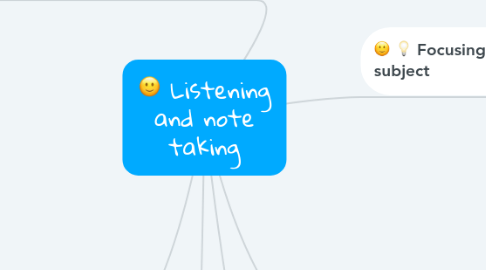Listening and note taking
저자: Austin Graves


1. Try different methods to maximize information gathering
1.1. Cornell Method
1.1.1. allows for pulling information and new concepts
1.1.2. neatly organized
1.2. Mapping method
1.2.1. Useful for learners who have a problem learning visually
1.2.2. helps to remember relationships between topics
1.3. charting method
1.3.1. facts are organized and easy to review
1.3.2. highlights key pieces of information
1.4. outlining method
1.4.1. Notes are taken more precisely and organized
1.4.2. easy to turn points into study questions
1.5. Sentence method
1.5.1. able to cover a lot of details quickly
1.5.2. notes are more simplified for studying and review
2. Better notes will lead to better studying and grades
2.1. making sure your notes are easily accessible and easy for you to read leads to productivity
2.2. Depending on a method that works, it will solidify success in that course
3. Be prepared!
3.1. have all of the tools at your disposal for great note taking
3.2. Alert with all the proper materials needed for listening and note taking
3.3. Paper, pencils, pens, highlighters
4. Focusing on the subject
4.1. Being ready with plenty of sleep is key!
4.2. Attentiveness and expectations to learn
5. Keep it as simple as possible
5.1. stick to keywords
5.1.1. Re-reading your notes
5.1.1.1. Highlight important topics
5.1.1.2. Add underlining to certain areas or subjects of importance
